Author: Haseeb, Managing Partner of Dragonfly; Translation: 0xjs@黄金财经
Is the market structure broken? Are VCs too greedy? Is this a manipulated game for retail investors?
Almost all the theories I've seen on this issue seem to be wrong. Let me speak with data below.
This is a widely circulated table made by X user tradetheflow, showing that a group of tokens recently listed on Binance are mostly falling. Most of them are ridiculed as "high FDV, low circulation" tokens, which means that they have high fully diluted valuations but small circulating supplies on the first day. I charted all of these and removed the labels. I excluded any explicit meme coins, as well as tokens that had TGEs long before Binance listed them, such as RON and AXL.
As below, BTC (beta) is in yellow:
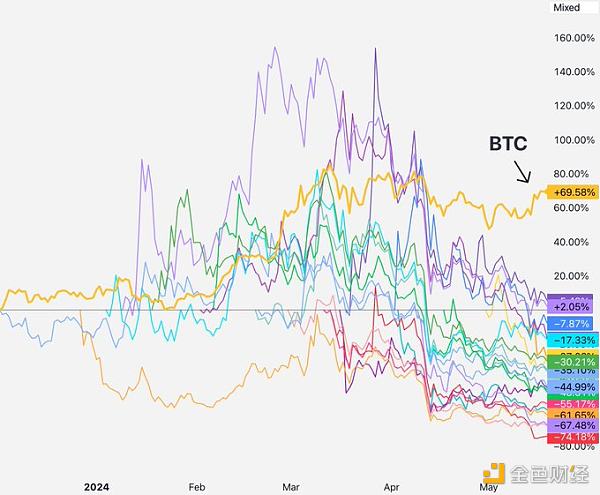
Almost all of these "low circulation, high FDV" Binance listed tokens fell. What can explain this? Everyone has a favorite theory about the destruction of market structure.
The three most popular theories are:
1. VCs/KOLs are dumping on retail
2. Retail investors are angrily abandoning VC coins and only buying Meme coins
3. Supply is too small for meaningful price discovery
All make sense theories! Let’s see if they are true. But to keep it scientific, we need a null hypothesis to refute. Our null hypothesis should be: these assets are all repriced, but there are no deeper market structure problems. (The classic “more sellers than buyers, over.”)
We will discuss each theory one by one.
1. VCs/KOLs are dumping on retail
If this is the case, what should it look like?
We should see tokens with shorter lockup periods sell off faster than other tokens, while projects with longer lockup periods or no KOLs should perform well. (Liquidity perpetual contracts could also be another vector for this dumping.)
So what do we see in the data?
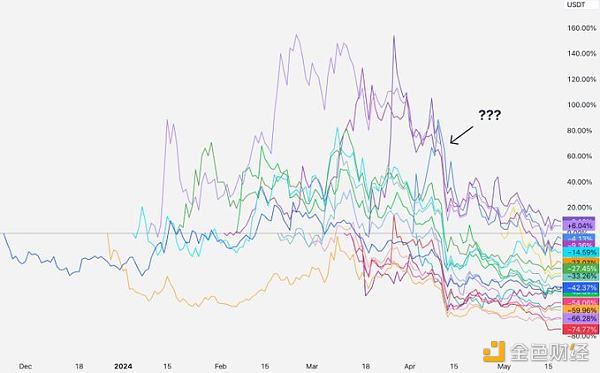
So from listing to early April, the tokens actually performed well - some were above the listing day price, some were below the listing day price, but most were concentrated around 0. Before then, there seemed to be no VC or KOL selling.
Then mid-April, everything went down. Did all of these projects, despite listing on many different dates and having many different VC investors and KOLs, all unlock in mid-April and start selling to retail?
I’ll make a personal disclosure here. I’m a VC. There are definitely VCs that are selling to retail, and yes, there are VCs that are not doing lockups, hedging over the counter, or even breaking lockups. But these are low-tier VCs, and most of the teams working with these VCs are not listed on tier-one exchanges. Every top VC firm you can think of has at least a year of lockup and multiple years of release before they get their tokens. In fact, 1 year lockup is mandatory for anyone regulated by the SEC under Rule 144a. Also, for large VCs like us, our positions are too large to hedge outside of exchanges, and we are generally contractually obligated not to do so.
So Here’s why this theory doesn’t make sense: Each of these tokens is less than a year away from the TGE, which means the VCs with 1 year lockups are still locked up!
Maybe some of these lower tier VC projects sold their tokens early, but all projects are down, even the top tier VC projects that are still locked up.
So it may be true that for some tokens, there are always some projects with bad behavior. But if all tokens fall at the same time, this theory cannot explain it.
Next theory.
2. Retail investors angrily abandon these tokens and only buy meme coins
If this is true, then what we should see is: the price of these new token issuances falls, and retail investors turn to meme coins.
Instead, what we see is this:
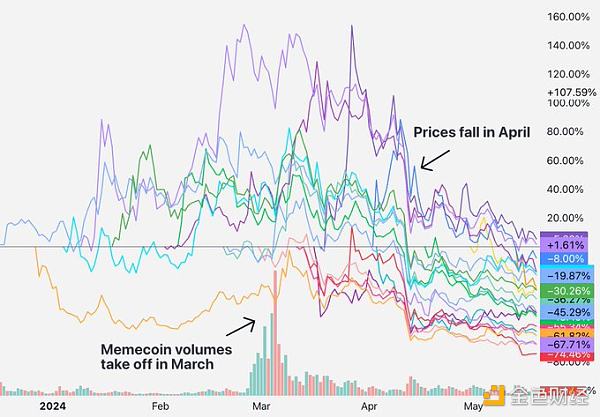
I drew a chart based on a basket of so-called low circulation and high FDV tokens relative to Meme coin trading volume. The timing was wrong. By March, the Memecoin craze had reached crazy levels, but a month and a half later in April, the entire basket of tokens was sold off.
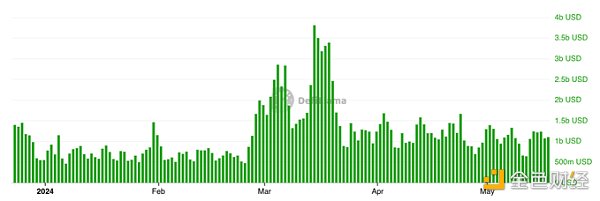
This is the trading volume on DEX on Solana, telling the same story - Meme coin exploded in early March before mid-April.
So this doesn’t match the data either. After the basket of so-called low-circulation, high-FDV tokens fell, there was no widespread rotation in meme coin trading. People are trading meme coins, but they are also trading new coins, and the trading volume does not support the narrative that retail investors are abandoning VC coins and turning to meme coins.
The problem is not the trading volume, but the asset price.
That is, many people are trying to sell the story that retail investors are disillusioned with real projects and are now mainly interested in meme coins. I visited Binance's Coingecko page and looked at the top 50 tokens by trading volume. About 14.3% of Binance's trading volume today comes from meme coin trading pairs. Meme coin trading is just a small part of what is happening in the cryptocurrency space. Yes, financial nihilism is a phenomenon, and is very prominent in crypto twitter, but most of the world is still buying tokens because they believe in some technical story, rightly or wrongly.
So, okay, maybe retail investors didn’t literally move from VC coins to meme coins, but here’s a sub-theory: VC firms owned too many of these projects, and that’s why retail investors rage-quit. They realized (in mid-April?) that these VC coins were all scams, and the project teams + VCs owned ~30-50% of the token supply. That must have been the straw that broke the camel’s back.
It’s a satisfying story. But I’ve been a crypto VC for a while. Here’s a snapshot of token distribution from 2017-2020:
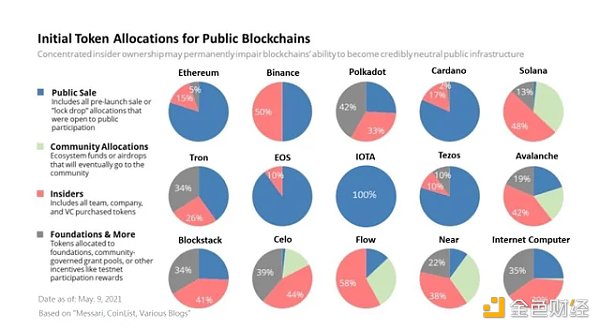
Look at the red shaded area - this is the share of insiders (team + investors). SOL 48%, AVAX 42%, BNB 50%, STX 41%, NEAR 38% and so on. The situation is similar today. So if the argument is that “the token was not a VC coin in the past, but it is now”, then this also does not match the data. Regardless of the cycle, capital-intensive projects always have teams and investors when they launch. Even after the tokens are fully unlocked, these “VC coins” continue to succeed.
In general, if what you are referring to also happened in the last cycle, then it cannot explain the unique phenomenon happening now.
So this story of “retail investors just rage quit and switch to trading meme coins” sounds true and is a good satire, but it does not explain the data.
Next theory.
3) Too little token supply for price discovery
This is the most common reason I've seen. Sounds good! It's not so sensational, which is its advantage. Binance Research even published a great report on this issue:

It looks like the average is about 13%. That’s super low, and significantly lower than past tokens, right?
Correct?
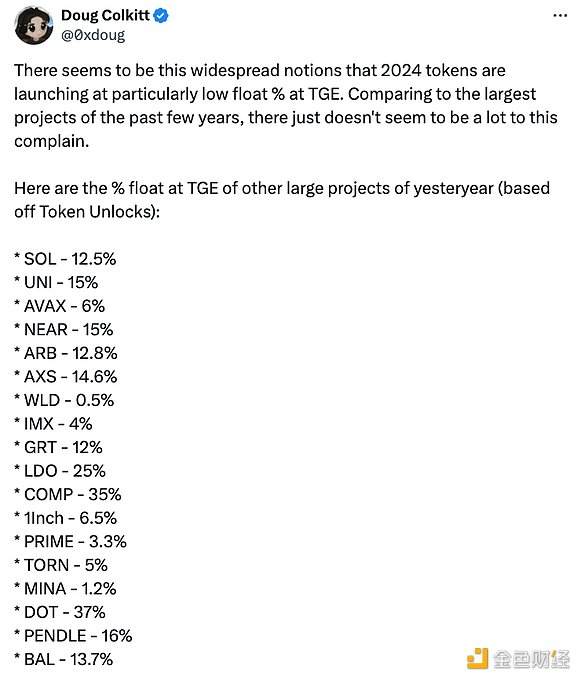
Thanks to 0xdoug for pulling this data. You guessed it, the average circulation of these tokens in the TGE last cycle was 13%.
Additional information: There is also a picture in the same article of Binance Research that has been widely circulated, claiming that the average circulation supply of tokens launched in 2022 is 41% at launch.
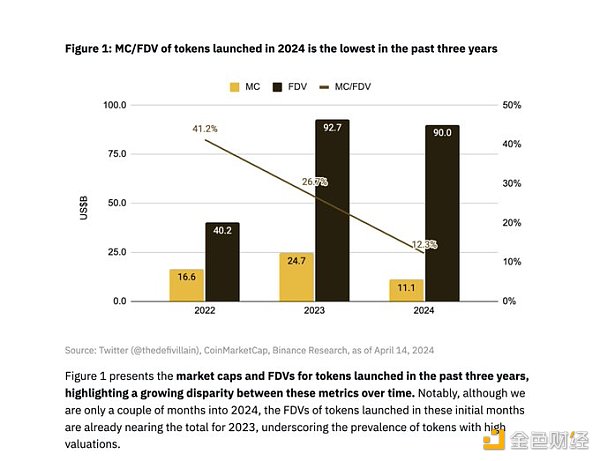
Sorry - what? My brother, I was in the industry in 2022, and the circulating supply did not reach 41% when the project was launched.
I extracted Binance's 2022 listings: OSMO, MAGIC, APT, GMX, STG, OP, LDO, MOB, NEXO, GAL, BSW, APE, KDA, GMT, ASTR, ALPINE, WOO, ANC, ACA, API3, LOKA, GLMR, ACH, IMX.
Spot-checking some of them, because these tokens don't all have data in TokenUnlocks: IMX, OP, and APE are similar to the latest batch of tokens we are comparing, with IMX having a circulation rate of 10% on the first day of listing, APE having a circulation rate of 27% on the first day of listing (but 10% of which is APE vault, so I rounded it up to 17% circulation), and OP having a circulation rate of 5% on the first day of listing.
On the other hand, there are LDO (55% unlocked) and OSMO (46% unlocked), but they were listed over a year before Binance, so it’s silly to compare those listings to the latest day one listings. If I had to guess, these non-Binance first listings plus random enterprise tokens like NEXO or ALPINE are the reason they’re getting such crazy high numbers. I don’t think they’re a true trend of TGEs — they’re a trend of tokens that Binance lists yearly.
Okay, maybe you’ll concede that 13% of circulating supply is similar to past cycles. But that’s still too little for price discovery, right? Stock markets don’t have this problem.
After all, just look at the median % in circulation on the first day of an IPO in 2023. Check the stock data. 12.8%. (H T@0xdoug)
But seriously, extremely low circulating supply is definitely a problem.WLD is a particularly egregious example, with just 2% circulating supply. FIL and ICP also had extremely low circulating supply at launch, which makes for very ugly price charts.But most of the tokens in the Binance chart group had circulating supply on the first day that was within historically normal ranges.
Also, if this theory was correct, you should see the tokens with the lowest circulating supply being penalized, while tokens with higher circulating supply should do well. But we don’t see a strong correlation. They all fell.
So this lack of price discovery story sounds compelling, but after looking at the data, I’m not convinced.
Solutions, Solutions
Everyone is complaining, but a few have come up with actual solutions! Let’s review them before we get to the null hypothesis.
A lot of people are suggesting resuming ICOs. Sorry - don't we remember ICOs that sold off and buried retail investors after listing? And ICOs are illegal almost everywhere, so I don't think this is a serious suggestion.
Multicoin Managing Partner Kyle Samani believes VCs and teams should unlock 100% immediately - which is impossible for US investors due to Rule 144a (also fuels the "VC dumping" theory). Also, I think we learned in 2017 why team vesting is a good idea.
Arca believes tokens should have bookrunners like traditional IPOs (note: when a company entrusts a bank to issue securities, it needs a lead underwriter, called a bookrunner). I mean, maybe? Token issuance is more like a direct listing, which is listed on an exchange with some market makers, and that's it. I think this is good, but I prefer simple market structures and fewer intermediaries.
Reganbozman of Lattice Fund suggests that project tokens should be listed at a lower price so that retail investors can buy in earlier and win some upside. I get the spirit, but I don’t think it works. Artificially lowering the price below the market clearing price means whoever trades in the first minute of trading on Binance will capture the mispricing. We’ve seen this happen multiple times with NFT minting and IDOs. Artificially lowering the listing price only benefits a few traders who fill their orders in the first 10 minutes.If the market thinks you’re worth X, then in a free market you’ll be worth X by the end of the day.
Some suggest going back to a fair launch.Fair launches sound good in theory, but don’t work well in practice because teams bounce. Believe me, everyone tried this during DeFi Summer. There aren’t a lot of success stories here - besides Yearn, what other non-meme coin fair launches have been successful in the past few years?
Many people have suggested that teams do larger airdrops. I think that makes a lot of sense! We generally encourage teams to try to provide more supply on day one to improve decentralization and price discovery. That said, I don’t think it’s smart to do ridiculously large airdrops just for liquidity - a protocol needs to do a lot to handle its tokens after day one to be successful, and burdening yourself with it on day one just to get ahead. Huge liquidity is not a smart move when you’re competing for token funding in the future. You don’t want to be one of those coins that has to re-increase its token supply a few years later because the coffers are empty.
So what do we as VC investors want to see happen here? Believe it or not, the token price in year one reflects reality. We are not paid on profits, but on DPI (Distributed to Paid in Capital), which means we have to convert tokens into cash eventually. We can't eat paper profits, and we don't mark unvested tokens to market valuation (anyone who does this is crazy in my opinion). It's actually a bad performance for VCs to reach astronomical valuations and then get stuck after we unlock. This makes LPs think that this asset class is fake - it looks good on paper, but it's terrible in reality. We don't want that. We want asset prices to rise gradually and steadily over time, which is what most people want.
So, are these high FDVs sustainable? I don't know. Compared to the numbers when projects like ETH, SOL, NEAR, and AVAX were first launched, these numbers are obviously eye-popping. But crypto is definitely bigger now, and the market potential for successful crypto protocols is significantly larger than it was in the past.
An important point 0xdoug made is that if you normalize last year’s altcoin FDV to today’s ETH price, you get numbers very close to the FDV we’re seeing today. Cobie echoed this in his recent post. We’re not going back to $40M FDV for L1 public chain tokens because everyone sees how big the market is now. But when SOL and AVAX launched, retail investors could pay prices comparable to ETH adjusted.
A lot of this frustration can be attributed to: crypto has risen dramatically over the past 5 years. Startups are priced based on comparable companies, so numbers like FDV will be larger.That’s it.
Okay, so it’s easy for me to criticize other people’s solutions. But what is my clever solution?
The honest answer?
No.
The free market will sort this out on its own. If the token goes down, then other tokens will re-price at lower prices, exchanges will push teams to launch at lower FDVs, buried traders will simply buy at lower prices, and VCs will pass this information on to founders. Series B will be priced lower due to public market comparisons, which will penalize Series A investors and eventually seed investors. Price signals always propagate in the end.
When there is a true market failure, you may need some kind of clever market intervention. But the free market knows how to fix pricing mispricings — just change the price. Those who are losing money, whether VC or retail, don’t need people like me to give their thoughts or debate on Twitter. They have internalized this lesson and are willing to pay less for these tokens. That’s why all these tokens are trading at a lower FDV, and future token transactions will be priced accordingly.
This has happened many times before. Just one minute.
4) Null Hypothesis
Now let’s demystify it. What exactly happened in April that caused all the tokens to fall?
The culprit: the Middle East.
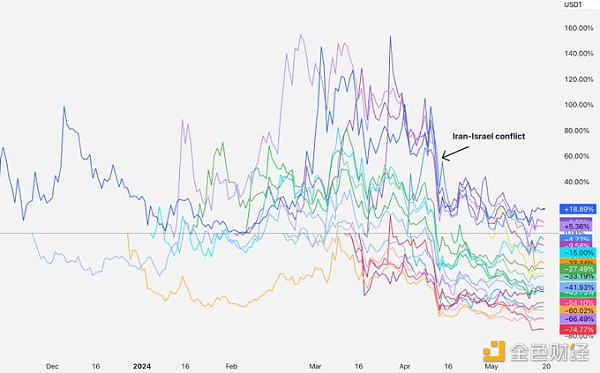
In the first few months, the trading of these tokens was mostly flat since listing until mid-April. Iran and Israel suddenly began to threaten World War III, and the market plummeted. Bitcoin later recovered, but these tokens did not.
So what is the best explanation for why these tokens are still down? My explanation is this: these new projects are all psychologically categorized as “risky new coins”. Interest in the “risky basket of new coins” dropped in April and has not recovered. Market players decided they didn’t want to buy them back.
Why? I don’t know. Markets are fickle at times. But if this basket of “risky new coins” had gone up 50% during this period instead of down 50%, would you still argue about how the token market structure is broken? That would also be a mispricing, just in the opposite direction.
A mispricing is a mispricing, and the market will eventually fix it. If you want to help — sell things at crazy prices and buy things at better prices. If the market is wrong, it will fix itself. No need to do anything else.
What to do?
When people lose money, everyone wants to know who to blame. Is it the founders? VCs? KOLs? Exchanges? Market makers? Traders?
I think the best answer is no one. (I’ll also accept the answer is everyone.) But thinking about market mispricing in terms of blame isn’t a productive framework. So I’m going to frame this in terms of what people can do better in this new market structure.
VCs: Listen to the market and slow down. Show price discipline. Encourage founders to be realistic about valuations. Don’t mark your lockup to market price (almost all the top VCs I know hold lockups at a significant discount to market price). If you find yourself thinking “there’s no way I could lose money on this deal,” you’re probably going to regret the deal.
Exchanges: List your tokens at a lower price. But you already knew that. Consider using a public auction to price your day one tokens, rather than pricing as a function of the last round of VCs. Don’t list a token unless all investors/teams have a contractual obligation to not hedge, and unless everyone (including KOLs) has a market standard lockup. Do a better job showing retail investors the FDV progress chart we all know and love, and educate them more about unlocks.
Teams:Try to offer more tokens on day one! Less than 10% of token supply is too low.
Of course, have healthy airdrops, and don’t be too scared of a low FDV on day one listing. The best price chart to build a healthy community is a gradual upward grind.
Don’t worry if your team’s token has fallen. Remember:
AVAX fell ~24% in 2 months after listing.
SOL fell ~35% in 2 months after listing.
NEAR fell ~47% in 2 months after listing.
You’ll be fine. Focus on building something to be proud of and keep delivering. The market will figure it out eventually.
For you, be careful of single cause and effect explanations. Markets are complex, and sometimes they just go down. Be suspicious of anyone who claims to confidently know why.
DYOR, don't invest anything you are not prepared to lose.
 Wilfred
Wilfred














